Archives
Reuters technical development chronology 1975-1979
Monday 13 July 2015
- The “Backbone” project starts with the aim of replacing the GTEIS/ADP North American exchange quotes feed with a Reuters-developed feed. IDN eventually manages this feat 11 years later. Backbone is cancelled three years later after consuming large quantities of expensive consultancy and internal effort.
- News is injected into Monitor pages via a news retrieval system which is fed from the editorial systems. Clients are to be offered one or more services - money, securities, commodities - though only money news goes live at this stage. The service has an alerts Monitor page, a fixed range of headline pages and space for the full text of news items. When a news alert occurs a flashing message points to the alert page and then the client can easily navigate to the story behind the headline. Editorial have to adapt to 64-character headlines and (ideally) fit a story within a Monitor page. They hate kowtowing to technical people but it does prepare them for a new world leading to today’s 140-character limit on Twitter posts. Monitor host storage is increased to cope.
- The first “special product” is installed in Den Norske Credit in the form of a standard “keyboard user interface”. This removes the need for dual input of rates (to Monitor and the client’s own computer). An engineering solution is chosen, avoiding a possible software minefield. The day will soon come when this kind of choice is no longer feasible.
- Hong Kong installs its own set of message switching systems also based on ADX technology and becomes technical HQ for Asia, displacing Singapore. It will of course switch back via Tokyo in the 1990s.
- A major contract is signed with the Long Island cable companies for distribution of Reuter services in Nassau County, New York. The legendary Oyster Bay service is born and may still be running somewhere in Hauppauge.
- Matching system technology is investigated for the first time with Tafex in San Francisco. It enables users to see the latest bids and offers and trade through the system. The market is deemed by Reuters to be not yet ready. Tafex soon ceases operations and is offered to Reuters but is considered too expensive.
- Monitor reaches 175 contributor/recipients and 896 recipients.
- An RCA satellite link delivers the now renamed Rowgrabber services to a convention of national cable TV companies in Dallas. The first time that Rowgrabber is shown outside New York.
- A “dual port” controller is developed allowing access to Monitor and QRS services from a single screen. It is based on the PDP-8A minicomputer.
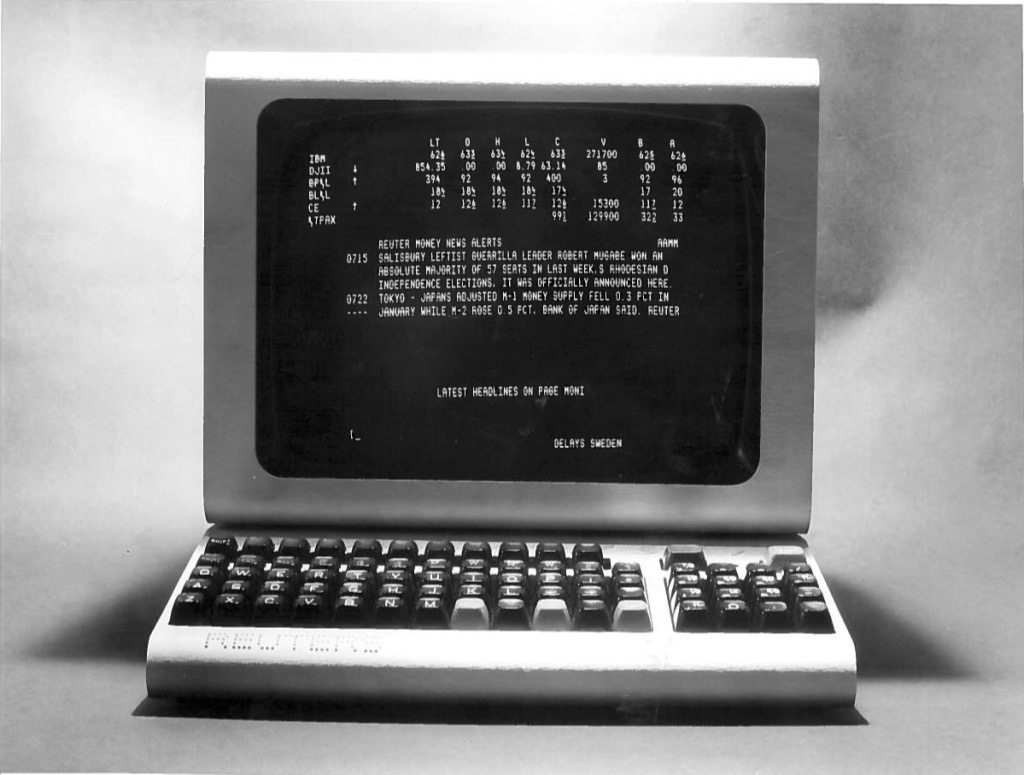 PHOTO: PD8-8A Monitor Quotes Terminal
PHOTO: PD8-8A Monitor Quotes Terminal
- DEC introduces the VAX range of machines intended to replace the PDP-11 although production of the latter continues until 1990.
- Engineering production in London and New York are dealing with pre-installation tasks for in excess of 200 PDP-8 based Monitor terminals per month. In addition, particularly in New York, systems are arriving from the manufacturer requiring basic assembly. Teams of engineers cope but the work undertaken before shipping to clients is causing delays and expense. The experience and knowledge of Intel microprocessor technology at IDR leads to the idea of a replacement Monitor terminal based on this new approach. So a skunk works enterprise in IDR builds a low cost, Intel-based replacement called the MES300. Initially disliked by London as too adventurous, it proves to be cheap, reliable and supports five keystations instead of three. More than 10,000 units are eventually produced. It revolutionises the Monitor product financials and field staffing and provides valuable cash flow for IDR. This helps offset the costs of developing and improving Rowgrabber. A large order for PDP-8s is cancelled which displeases DEC who had set up a new manufacturing facility in Galway, Ireland in anticipation.
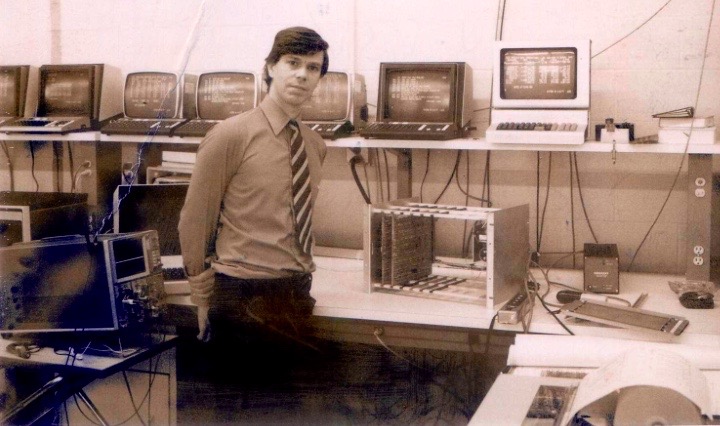 PHOTO: Peter Howse with MES300
PHOTO: Peter Howse with MES300
- A major project - ESS (Editorial Support System) - is announced to replace the ADX installed in 1968 with more capacity and a state of the art video editing terminal based on PDP 11/04 minicomputers.
- Communications capacity continues to be an obstacle and multiplexing solutions are thoroughly investigated. Finally SWM is resurrected from its slumbers and a team is put in place to develop a general purpose packet-switching network. The aspiration is to provide a secure highly available connection between data centres and clients as well as between data centres. It suffers many delays and setbacks and eventually surfaces as the basis for Dealing conversations but is never used for any other product.
- The Stockmaster service has by now been renamed QRS or Quotation Retrieval Services. The QRS main feed of prices from the world stock and commodity exchanges known as the “backbone” is increased in speed from 2400 baud to 4800 baud.
- Regulatory obstacles and line availability continue to be constant threats to expansion and revenue growth. Reuters also has to contend with outdated carrier technology and monopolistic behaviour by telecommunications authorities. Line ordering times are as long as 13 months in the UK. Reuters and other members of INTUG which, by now has become a very powerful user group, slowly improve the situation.
- After a year of fraught development activities and a 50 per cent escalation in costs, ESS is cancelled in its current form amid much acrimony because of the continual changes to the specification. Huge effort has gone into designing the perfect system. The terminal survives in a reduced form but the other components are to be reviewed and possibly scrapped.
- North America continues to focus on the strategy of broadcasting data using spare capacity on existing television cable networks which are widely available in most US cities. It is attractive as it avoids the obstacles posed by traditional two-way communications owned by obstructive PTTs as in Europe. Glen Renfrew is convinced that such broadcast technology could leapfrog Reuters into a dominant position in the United States at least. Availability of cable and satellite communications outside North America is still a problem. In a partnership with Intel, development starts on a discriminator chip. This is designed to replace the complex “grabbing” circuitry in the Rowgrabber terminal which unscrambles the television signal and extracts the data carried. The chip is also intended to overcome the limitations of character sets and other aspects in the original design. Enormous investment (perhaps in excess of $1.7 million) is made in the discriminator chip over the life of Rowgrabber.
- Quote-11, a PDP-11 based market ticker system, replacing the original PDP-8 systems, enters service in New York.
- The design of the Dealing Conversations system starts.
- The future limits of the Monitor system become a discussion point and a replacement system is conceived, known imaginatively as RSR (Retrieval System Replacement). The very success of Monitor is becoming its undoing as local initiatives spring up throughout the world adding to capacity problems. The RSR design proposal suggests a partnership with either IBM or DEC.
- A new IDR terminal known as the Multi Access Terminal allows Rowgrabber services to be delivered to remote subscribers in the United States by telephone lines. A first sign that access to Rowgrabber services was not as straightforward as just “following the cable”.
- The development of the Dealing system now starts in earnest. This follows clearance from European telecommunications authorities. There had been serious doubt as to whether the European Conference of Postal and Telecommunications Administrations (CEPT - Conférence Européenne des administrations des Postes et des Télécommunications) would allow a dealing service. Approval is conditional on a volume related tariff but it is still a remarkable breakthrough.
- The scale of the undertaking leads to a decision to contract out the project to two software houses: CAP and Hoskyns who use a third, Scicon, as a subcontractor. A fourth, Logica, provides some additional design expertise. Overall architecture and design is owned by CAP. The system comprises a pair of service machines in London based on the most powerful PDP-11s of the day, which manage the administration of the service and the initiation of “dealing conversations” between clients. The network is provided by Reuters in the form of SWM, in development since 1977. It has its moment of glory and controls the connection between clients after the conversation is set up. It guarantees delivery of the packets of conversation text and routes them appropriately and securely, avoiding failure points. It is configured to ensure a contact time between counterparties of under four seconds which is a key marketing point for the product. It is also based on PDP-11s. A Monitor connection is provided via the network to provide the client with that service on the terminal. The terminals are based on PDP-8s in spite of previous experience with the Monitor variant. They can be downloaded to avoid a field visit. This takes 13 minutes, a fact which many members of the sales force will remember, as they talk through a terminal software failure during a demonstration to clients (or in one famous incident to Reuters chairman Sir Denis Hamilton). “I am now demonstrating a Dealing Controller being refreshed with new software, etc.” After January 1979, the final testing and integration functions are provided by Reuters. It is expected to go live during 1979 with initial subscriber numbers of 120, forecast to expand to 350 by the third year. The system adopts the standard DEC software environment of RSX-11 with a middleware component written by Reuters known as REX (Reuters Executive). This causes support problems of its own in years to come such that Dealing and a small but vital part of Monitor remain the only users of a quasi-unsupported lump of complicated software. Thin ice.
- The company wrestles with inflexible manpower in London development due to restrictions on temporary staff, rate-for-the-job agreements, an inability to reward performance and a general lack of suitable staff in the market place. It puts the trading and business organisations at loggerheads. Arguments on what constitutes development work continue with the creation of interface groups between operations/field and development. Some product releases suffer unacceptable delays.
- Two new news retrieval services, Commodities and Securities, are finally launched three years after Money news. Hardly a sterling performance.
- A move is made to a new location in Great Sutton Street (GSS), an old carpet warehouse, where for the first time development and London operations are housed in the same location. The “new” building is opened by the chairman Sir Denis Hamilton. DEC VAXs are purchased to provide the software development environment and enable developers to gain experience of this next generation system.
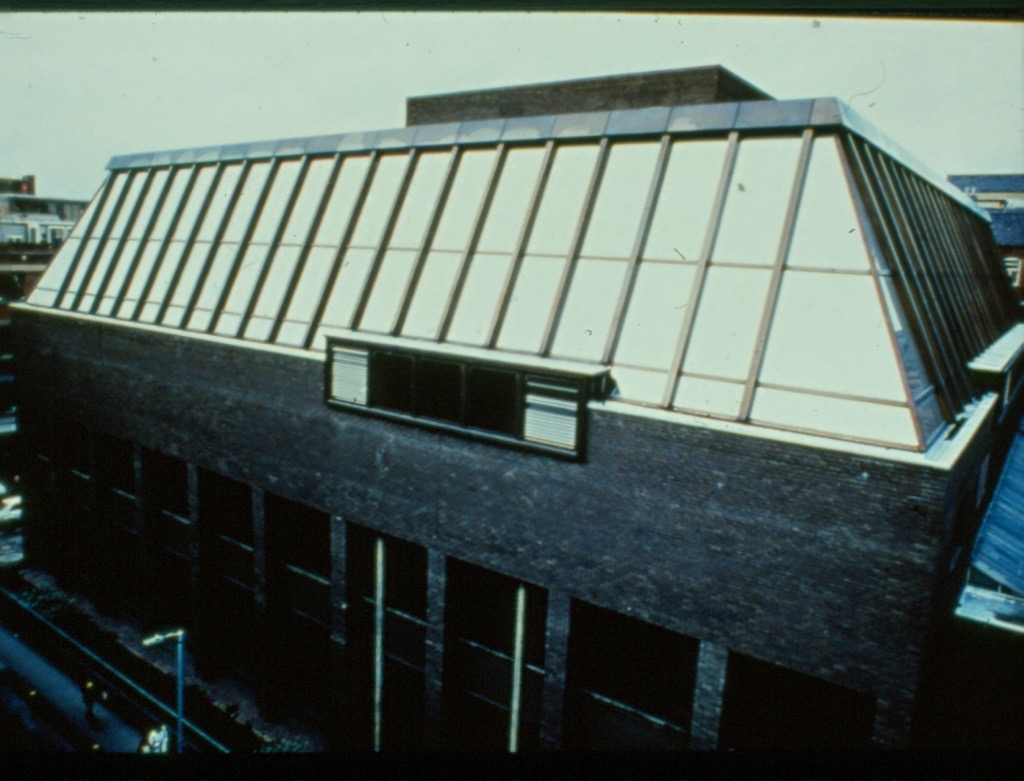 PHOTOS: London Technical Centre in Great Sutton Street and plaque commemorating its opening by chairman Sir Denis Hamilton
PHOTOS: London Technical Centre in Great Sutton Street and plaque commemorating its opening by chairman Sir Denis Hamilton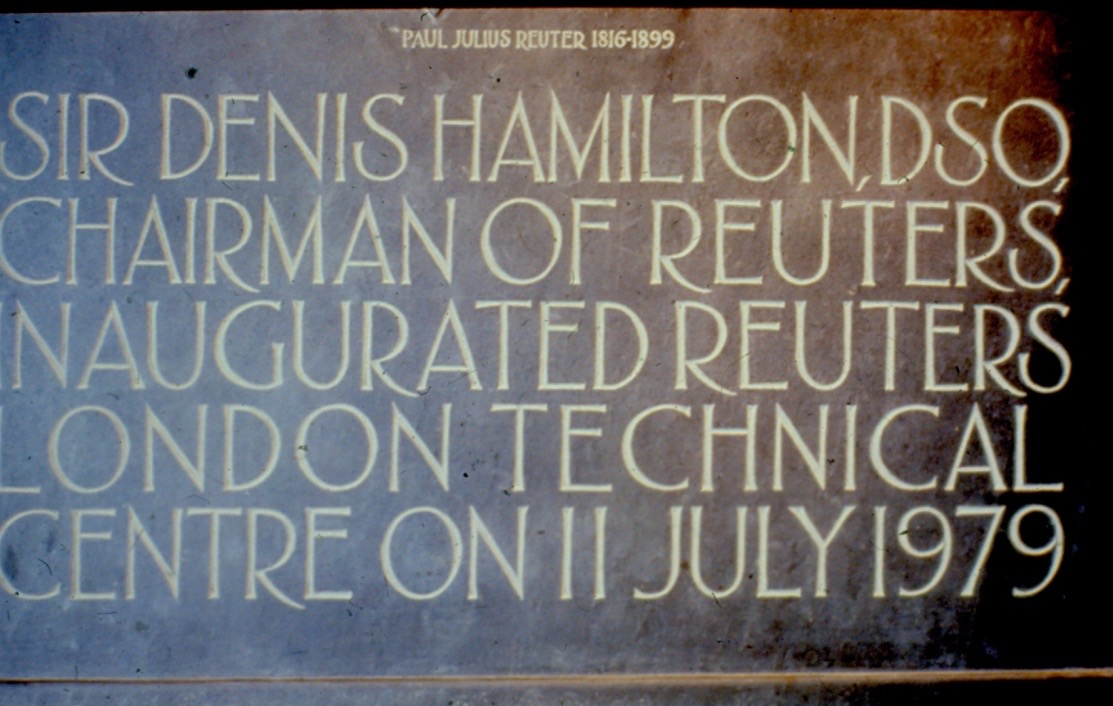
- Industrial unrest in RNA results in the Teamsters bidding for programmer representation. This fails and the software staff eventually leave The Newspaper Guild of New York.
- Work starts in RNA on a “two-way” grabber system. A terminal can request, via a separate network, slower moving information that is not in the main broadcast stream. This reduces the need to continually broadcast everything. The relationship between the Intel-designed discriminator chip in the terminal and the cable head system, which organises the broadcast flow, starts to be problematic. Complicated algorithms are devised to interleave data in the output of the cable head in such a way that the terminal can process it reliably. Further development by IDR results in a completely redesigned terminal designated the 4P. However access of the physical coaxial cable inside or outside the client building results in a whole new subset of obstacles which prove insurmountable in the long term.
- The ESS 11/04 video editing terminal goes live in London but connected to the ADX rather than a replacement network as originally conceived.
- By this point Reuters had acquired considerable expertise in the development, operation and field support of a truly global real-time network - the world’s first and amongst the largest. This can now be seen as a major contributor to future success.
- Work begins on a new technical centre in Geneva.
- Monitor feeds a variety of information services such as Prestel in the UK and Minitel in France.
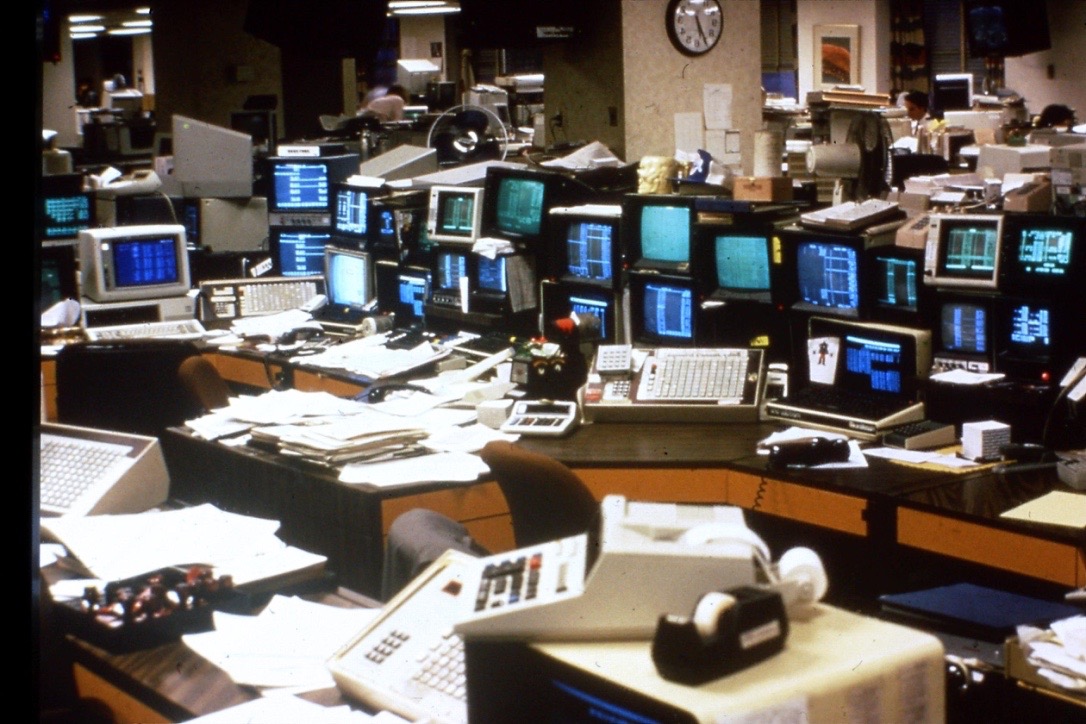 PHOTO: Life before interface products
PHOTO: Life before interface products
- Effort focuses on the problems of the trading room where ever more screens and keyboards are cluttering traders’ desks. QRS and Monitor services have been available on a single screen and keyboard through the dual port PDP-8A. A new terminal is developed based on a PDP-11 with an additional facility (or third port) which gives access to specific clients’ in-house IBM computers through an IBM3270 emulation. Merrill Lynch is the first customer. This Third Port Terminal will prove horribly complex to get right as emulating IBM protocols on a PDP-11 is not for the faint-hearted and the project was certainly a loss leader. New devices, known as Special or Interface Products, provide screen and keyboard switching which with a programmable keyboard enable one position to view multiple data sources including any client-required service. One of the first installations is at Morgan Guaranty Trust and involves 19 PDP-8 terminals, 204 video screens and 86 keyboards. Early marketing policies mean that competitor services could not be viewed on Reuter terminals. However the lucrative business of solving the problem of real estate on the client’s desk is under way.
- Although the dual port PDP-8A is successful it has been expensive to maintain and the cost effectiveness of the MES300 Intel-based terminal turns minds towards a replacement. So work begins in London on a new Multi-Purpose Terminal (MPT) for information products.
- « Previous
- Next »
- 6 of 18